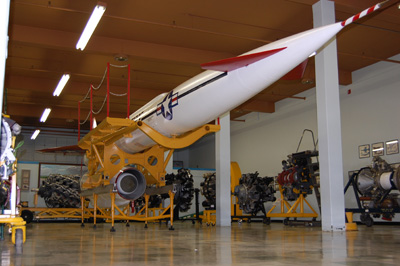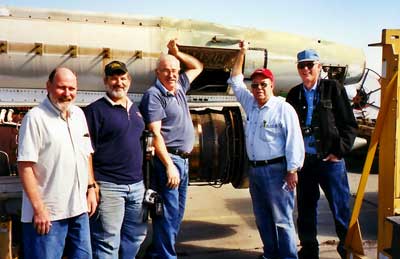|
|
General J.H. Doolittle
Tokyo Raiders Reunion, 2003
|
|
The Jimmy Doolittle Air and Space Museum Foundation and Travis Air Museum have an extremely interesting and wide variety of collections. Our weapons, engines, aircraft nose art, models, original photographs, aviation sculptures, military coins and uniforms are a delight to any craftsmen’s or artisans’ eye. The following represents an example of our holdings:
Doolittle Tokyo Raider Exhibit
Thanks to the Doolittle Raiders the Jimmy Doolittle Air and Space Museum Foundation has acquired an incredible collection of artifacts and memorabilia from that raid. Most of the items have been donated by a Raider himself, or his family.

Raider Stork Album - J.R. Stork
The etched leather bound photo album pictured here is currently available to see in the Travis Air Museum exhibit building. In fact, in addition to a large, very complete Jimmy Doolittle Life and Times exhibit, there is an equally satisfying Doolittle Tokyo Raider exhibit with a number of original artifacts brought back with the survivors of that historic day.
For example, the pictured album, donated by a nephew of J.R. Stork, a member of crew #10, contains a photographic history of his time in the Army Air Corp. Starting with his basic training in Texas, the photos take us through his flight training and onto the training for the raid over Tokyo. There are pictures of B-25s that didn’t make it off the runway while training for the un-heard-of short take-off requirements from a carrier; a photo of Jimmy Doolittle working with the crews, a shot from another ship of the carrier Hornet underway, and another of the actual take-off from the Hornet for the bombing raid.
Among the hundreds of items Roy Stork brought back from his adventure is his rip cord parachute handle. There is an original letter to Robert C. Bougeois on White House stationery with congratulations from President Harry Truman. Only three cameras survived the raid on the Yokosuka Naval Base, and we have the photos on display taken from a window of a B-25 during the raid on the base as they flew over and bombed it. This is only a small example of what we have.
Armament: AGM-28 Hound Dog Missile

AGM-28 Hound Dog
The North American AGM-28 Hound Dog was the first air-launched nuclear stand-off missile deployed by the United States.
Development
The development of the nuclear stand-off missile was initiated by the USAF in 1956. Initially known as Weapon System 131B, it was intended to give Strategic Air Command heavy bombers the ability to attack Soviet targets from outside enemy airspace. The first powered flight of the prototype missile, designated XGAM-77, was made in April 1959. The missile's engine, airframe, and warhead were straightforward adaptations of existing technology, so the weapon's development period was quite short, and the production GAM-77 entered operational service in December 1959. It received the popular name Hound Dog, apparently inspired by the contemporary hit song by Elvis Presley.
Hound Dog was essentially an unpiloted jet airplane with small delta wings and forward canards. It was powered by a single Pratt & Whitney J-52-P-3 turbojet in a ventral pod beneath the rear fuselage, with 7,500 lbf (33 kN) thrust. It used inertial navigation for guidance, with heading updates provided by astro-trackers mounted in the launch pylon. The W28 warhead (the same as the B28 nuclear bomb) had an explosive yield of 1.1 megatons. The missile's maximum range was about 700 miles (1,100 km).
The Hound Dog was carried by B-52 Stratofortress bombers; the B-52D, B-52G and B-52H were fitted with provision for the large under-wing pylons to launch the weapons, each bomber normally carrying one under each wing. The Hound Dog's fuel tanks, interestingly, could be topped up from the B-52's own fuel supply, and before launch its engines could be used as auxiliary booster engines for the bomber. The missile's inertial navigation system (INS) could be used as a backup system for determining the aircraft's position after the initial calibration and "leveling" which took a minimum of 90 minutes.
The GAM-77 was subsequently upgraded to GAM-77A standard, with improved astro-trackers now mounted in the missile, rather than the pylon, a radar altimeter, and larger fuel capacity. The upgrade made possible several different altitude profiles, such as high altitude launch/high altitude cruise (high/high) or high altitude launch/high altitude cruise followed by a descent to terrain following cruise (high/high/low). Other options were high/low, low/high, low/low and low/high/low.
In June 1963 the GAM-77 and GAM-77A were redesignated AGM-28A and AGM-28B, respectively. An updated AGM-28C, with improved guidance, was proposed in the early 1970s, but never built.
A total of about 700 Hound Dogs were produced. They were intended to be replaced by the AGM-48 Skybolt, which did not enter service. The last Hound Dogs were retired in 1976.
Specifications
- Length: 12.95 m (42 ft 6 in)
- Wingspan: 3.66 m (12 ft)
- Diameter: 0.71 m (28 in)
- Launch weight: 4,500 kg (10,000 lb)
- Speed: Mach 2.1
- Ceiling: 16,800 m (55,000 ft)
- Maximum range: 1,100 km (700 miles)
- Guidance: inertial: with astro-tracker heading correction
- CEP: 13,000 feet
- Warhead: W-28 thermonuclear (1.1 MT)

Hound Dog Restoration Crew
The Travis Museum Hound Dog restoration team members pictured in the photo carried out the initial inspection and assessment of the dog. They are, left to right, Lloyd Brunsen, Dave Stone, Mike Frankhouser, Neil Wood, and Gene Hollingsworth.
Continue with Armament: PB4Y-2 Bow Turret (Model Number 250SH-3)
|
|